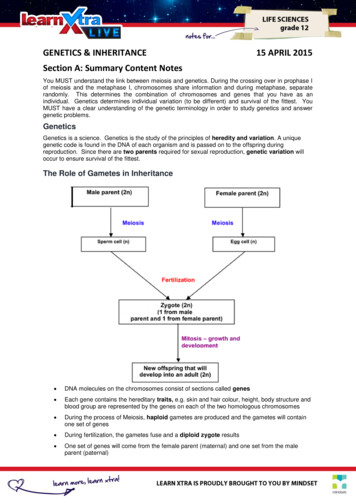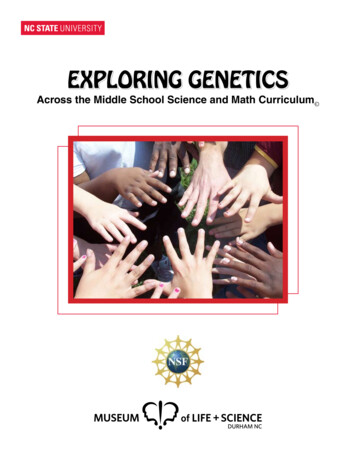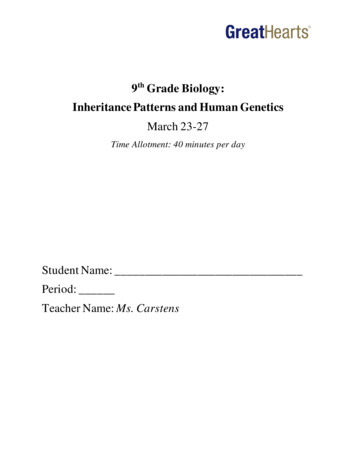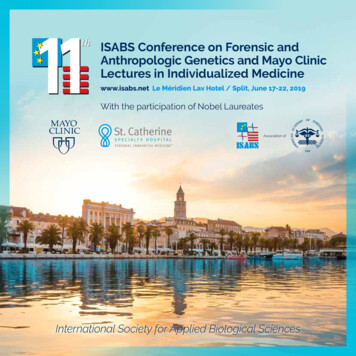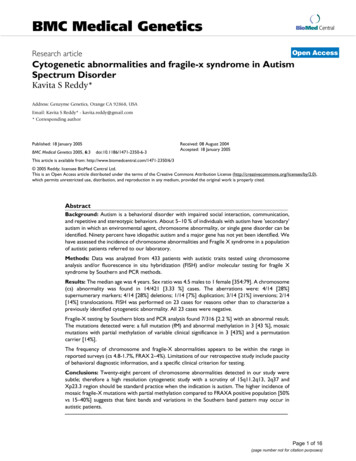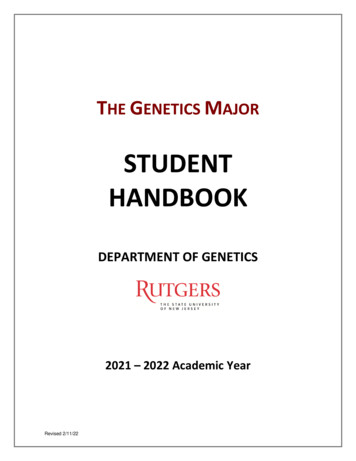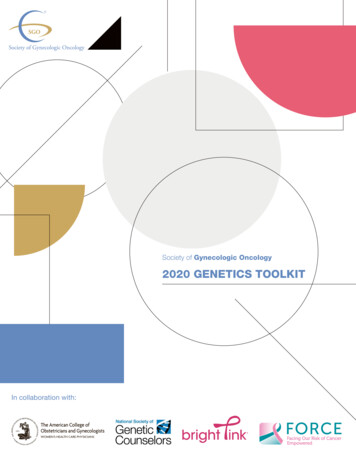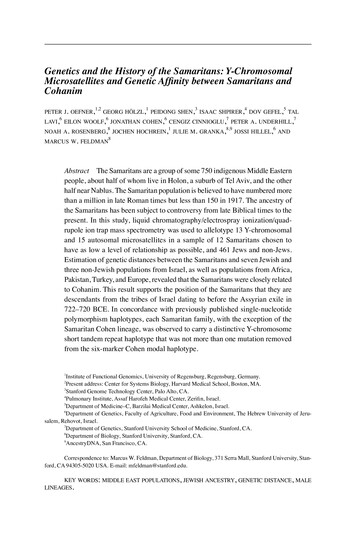
Transcription
Genetics and the History of the Samaritans: Y-ChromosomalMicrosatellites and Genetic AfÀnity between Samaritans andCohanim1,2PETER J. OEFNER,61345GEORG HÖLZL, PEIDONG SHEN, ISAAC SHPIRER, DOV GEFEL, TAL6677LAVI, EILON WOOLF, JONATHAN COHEN, CENGIZ CINNIOGLU, PETER A. UNDERHILL,81NOAH A. ROSENBERG, JOCHEN HOCHREIN, JULIE M. GRANKA,8,9MARCUS W. FELDMAN6JOSSI HILLEL, AND8Abstract The Samaritans are a group of some 750 indigenous Middle Easternpeople, about half of whom live in Holon, a suburb of Tel Aviv, and the otherhalf near Nablus. The Samaritan population is believed to have numbered morethan a million in late Roman times but less than 150 in 1917. The ancestry ofthe Samaritans has been subject to controversy from late Biblical times to thepresent. In this study, liquid chromatography/electrospray ionization/quadrupole ion trap mass spectrometry was used to allelotype 13 Y-chromosomaland 15 autosomal microsatellites in a sample of 12 Samaritans chosen tohave as low a level of relationship as possible, and 461 Jews and non-Jews.Estimation of genetic distances between the Samaritans and seven Jewish andthree non-Jewish populations from Israel, as well as populations from Africa,Pakistan, Turkey, and Europe, revealed that the Samaritans were closely relatedto Cohanim. This result supports the position of the Samaritans that they aredescendants from the tribes of Israel dating to before the Assyrian exile in722–720 BCE. In concordance with previously published single-nucleotidepolymorphism haplotypes, each Samaritan family, with the exception of theSamaritan Cohen lineage, was observed to carry a distinctive Y-chromosomeshort tandem repeat haplotype that was not more than one mutation removedfrom the six-marker Cohen modal haplotype.1Institute of Functional Genomics, University of Regensburg, Regensburg, Germany.Present address: Center for Systems Biology, Harvard Medical School, Boston, MA.3Stanford Genome Technology Center, Palo Alto, CA.4Pulmonary Institute, Assaf Harofeh Medical Center, ZeriÀn, Israel.5Department of Medicine–C, Barzilai Medical Center, Ashkelon, Israel.6Department of Genetics, Faculty of Agriculture, Food and Environment, The Hebrew University of Jerusalem, Rehovot, Israel.7Department of Genetics, Stanford University School of Medicine, Stanford, CA.8Department of Biology, Stanford University, Stanford, CA.9AncestryDNA, San Francisco, CA.2Correspondence to: Marcus W. Feldman, Department of Biology, 371 Serra Mall, Stanford University, Stanford, CA 94305-5020 USA. E-mail: mfeldman@stanford.edu.KEY WORDS: MIDDLE EAST POPULATIONS, JEWISH ANCESTRY, GENETIC DISTANCE, MALELINEAGES.
826 /OEFNER ET AL.The origin of the Samaritans, a distinct religious and cultural minority in theMiddle East, has generated controversy among historians, biblical scholars, andorthodox Jewish sects (Talmon 2002). According to Samaritan tradition, theyare descendants of Ephraim and Manasseh, sons of Joseph, and Levitical priests,from Shechem (traditionally associated with the contemporary city of Nablus).Early Jewish sources such as the writings of the Àrst-century historian Josephusassumed that the Samaritans of their day descended from the inhabitants resettledin the biblical northern kingdom of Israel after its conquest by the Assyrians in722–721 BCE. Jews like Josephus doubted the authenticity of Samaritan identity,suspecting them of feigning Israelite identity out of opportunism and self-interest.Their suspicions can be traced back to biblical descriptions of the northern kingdomand its inhabitants during the period of Assyrian conquest.We know of this conquest from Assyrian sources themselves. It was thecustom of the Assyrians to replace the people of a conquered area by people fromelsewhere. This practice was applied to the Kingdom of Israel (referred to by theAssyrians as Samaria) as we know from the Nimrud Prisms, inscribed clay documents discovered during the excavation of Nimrud that narrate the campaigns ofthe Assyrian ruler Sargon (Fuchs 1994):The inhabitants of Samaria/Samerina, who agreed [and plotted] with a king[hostile to] me not to do service and not to bring tribute [to Ashshur] and whodid battle, I fought against them with the power of the great gods, my lords.I counted as spoil 27,280 people, together with their chariots, and gods, inwhich they trusted. I formed a unit with 200 of [their] chariots for my royalforce. I settled the rest of them in the midst of Assyria. I repopulated Samaria/Samerina more than before. I brought into it people from countries conqueredby my hands. I appointed my eunuch as governor over them. And I countedthem as Assyrians. (Nimrud Prisms, COS 2.118D, 295–296)This aspect of the conquest is corroborated by the biblical book of Kings, whichalso refers to the resettlement:And the king of Assyria brought men from Babylon and from Cuthah andfrom Ara and from Hamath and from Sepharaim and placed them in the citiesof Samaria instead of the children of Israel and they possessed Samaria . . .(II Kings 17: 24)According to 2 Kings 17, these new inhabitants adopted the worship of theIsraelites’ God but mixed it with the worship of their own gods, a syncretism thatwas highly offensive to the author of 1 Kings. Later, according to the biblicalbook of Ezra, the descendants of this resettled population would try to participatein the newly rebuilt temple in Jerusalem but were rejected by the people of Judah,newly returned from Babylonian exile themselves, and as a result became hostileadversaries of the people of Judah. Josephus and other early Jews inferred from
Genetic Origins of Samaritans / 827such stories that the Samaritans were pseudo-Israelites, building their temple atMount Gerezim (in the vicinity of Shechem/Nablus) in imitation of the JerusalemTemple and inventing a genealogy for themselves that traced their origins backto the biblical tribes of Israel—but only feigning Israelite identity when it was intheir interest to do so and sometimes reverting to a foreign identity. Much laterSamaritan sources remembered history very differently, accusing the Jews’ ancestors of religious defection and imposture, and condemning the Jerusalem templeas an imitation of the authentic Mosaic cult on Mount Gerezim (Talmon 2002).The book of Chronicles compounds the difference in interpretation ofSamaritan history. Recalling that Hezekiah ruled the southern kingdom of Judeafrom 715 BCE, after the Assyrian victory, the following passage seems to contradictthe above statement from II Kings:And Hezekiah sent to all Israel and Judah and wrote letters also to Ephraimand Manasseh that they should come to the home of the Lord at Jerusalem tokeep the Passover.” (II Chronicles 30: 1)Since the Samaritans view themselves as the descendants of Ephraim and Manasseh,it could be that this verse of Chronicles actually implies that King Hezekiah wastrying to contact Israelites from Samaria, and that some Samaritans remained inthat area after the Assyrian conquest.Contemporary historians are thus left with different, inconsistent accountsof Samaritan origins. An early Jewish source such as Josephus seeks to distinguishthe Samaritans from the Israelites and their Jewish descendants, though he acknowledges the presence among the Samaritans of Jews like the biblical Manasseh,brother of a high priest, who is alleged to have played a role in the formation ofthe Samaritan temple on Mount Gerezim. Samaritan sources, on the other hand,emphasize the Israelite pedigree of the Samaritans, asserting their genealogical aswell as religious connections to the people of the Five Books of Moses. Neithertextual analysis nor the archaeological excavation of sites like Gerezim has beenable to settle the issue of Samaritan origins or their relationship to the Jewishculture that developed in the Second Temple period (Plummer 2009; Weitzman2009; Zsellengér 2011).During Roman times (fourth and Àfth centuries CE), the Samaritan populationis believed to have reached more than a million, but persecution, forced conversion,and forced migration by subsequent rulers and invaders decimated the populationto the extent that they numbered 146 in the year 1917 (Ben Zvi 1957).Samaritan writing, which resembles ancient Hebrew, is used in their HolyScriptures. They observe the tenets of the Hebrew Bible, the Torah, but not theother parts of the Jewish scriptures. In addition, membership in the Samaritangroup is transmitted along the male line, as opposed to the post-biblical rule ofJewish transmission, which is maternal. Children of Samaritan males who marrynon-Samaritan females are included as Samaritans, but females who marry outsidethe Samaritan community are expelled.
828 /OEFNER ET AL.Marriage among Samaritans is mostly endogamous, and the group is highlyinbred, with 84 percent of marriages between either Àrst or second cousins. Themean inbreeding coefÀcient of 0.0618 is among the highest recorded amonghuman populations (Bonné-Tamir et al. 1980). Important genetic and demographicstudies by Bonné and colleagues (1963, 1965, 1966) revealed differences in manytraits from other Middle Eastern populations. For example, blood group O andcolor blindness are more frequent in Samaritans, while G6PD deÀciency is lessfrequent. Their endogamous marriage customs and patrilineality have exacerbatedthe historical exclusion of the Samaritans by Orthodox Judaism, which is strictlymatrilineal.Cazes and Bonné-Tamir (1984) detailed pedigrees among the Samaritans.There are four lineages: the Tsedaka, who claim descent from the tribe of Manasseh;the Joshua-Marhiv and DanÀ lineages, who claim descent from the tribe of Ephraim;and the priestly Cohen lineages from the tribe of Levi (Ben Zvi 1957; Schur 2002).The historical and biblical sources leave us with two main hypotheses for theorigin of Samaritans. The Àrst, which is argued by the orthodox Jewish authoritiesand a few modern scholars (Kaufman 1956), is that Samaritans are not Israelites atall but were brought to Israel by the Assyrian king when he conquered Israel andexiled its people. If this view were true, assuming that modern Jewish populationsare continuous with the ancient Jewish populations, we would not expect similarityof Samaritans and modern Jewish populations. The second hypothesis, which isargued by the Samaritans themselves, is that they are descendants of Israelites whoremained in Israel after the Assyrian conquest and diverged from the mainstreammore than 2500 years ago. They remained isolated until the present time (althoughforeign elements from the surrounding Arabic people have been incorporated intotheir style of life). The Israeli historian S. Talmon (2002) supports the Samaritans’claim that they are mostly descendants of the tribes of Ephraim and Manassehthat remained in Israel after the Assyrian conquest. His opinion is that the statement in the Bible (II Kings 17: 24) is tendentious and intended to ostracize theSamaritans from the rest of Israel’s people (see also Cogan and Tadmor 1988). Infact, II Chronicles 30: 1 may be interpreted as conÀrming that a large fraction ofthe tribes of Ephraim and Manasseh (i.e., Samaritans) remained in Israel after theAssyrian exile.The present study aims to address the two hypotheses for the origin of theSamaritans by analysis of 13 Y-chromosomal short tandem repeat (STR) markersin various Jewish and non-Jewish populations from Israel, Africa, Southwest Asia,and Europe, as well as 15 autosomal STRs in the Samaritan and Israeli samplesonly. Allelotyping was accomplished by liquid chromatography-electrosprayionization-quadrupole ion trap mass spectrometry (Oberacher et al. 2001a, 2001b,2003), which allowed not only the accurate determination of allele size but alsothe simultaneous detection of single-nucleotide polymorphisms (SNPs), severalof which proved informative and enabled the generation of so-called SNPSTRs(Mountain et al. 2002). The study Ànds statistical evidence that the male lineagesrepresented by the Y-chromosomes present in today’s Samaritans are very similar
Genetic Origins of Samaritans / 829to those of Cohanim, supporting the view that Samaritans have ancient roots inthe Israelite population.Materials and MethodsSubjects.Blood samples were taken from 47 Samaritans living in Holon, acity just south of Tel Aviv, after they had given their written consent accordingto the regulations of the Helsinki Committee. Blood samples were kept at –80 Cuntil phenol/chloroform extraction of DNA from white blood cells. We originallysampled 27 males, but upon examination of their pedigrees, only one of any pairof individuals more closely related than great-grandfather/great-grandson was retained. The Ànal sample comprised 12 individuals for analysis of Y-chromosomalpolymorphism: two each from the Cohen and DanÀ lineages, and four each fromthe Joshua-Marhiv and Tsedaka lineages.In addition to the 12 Samaritan individuals, we included in the study 20Ashkenazi Jews, 20 Iraqi Jews, 20 Libyan Jews, 20 Moroccan Jews, 20 YemeniteJews, 17 Ethiopian Jews, and 25 Israeli Cohanim. Data for all but the Cohanim, aswell as 18 Druze and 20 Palestinians, were obtained from the National Laboratoryfor the Genetics of Israeli Populations at Tel Aviv University. The 25 unrelatedCohanim and 19 additional unrelated Palestinians were sampled in Israel with theirwritten consent according to the regulations of the “Helsinki Committee.” Thus, theIsraeli sample included 12 Samaritans, 142 Jews, and 57 non-Jews. From the HumanGenome Diversity Panel (HGDP) maintained at Centre d’etude du polymorphismehumain in Paris, 28 Bedouins, 23 individuals from Russia (including 16 Russiansand seven Adygei from the Russian Caucasus), 29 Italians (including 14 Sardinians),20 Burusho, 24 Brahui, 23 Balochi, 20 Pathan, and 20 Kalash were included in thestudy. Twenty-four African DNA samples were obtained from the Y-ChromosomeConsortium collection, and 50 Turkish samples were selected randomly from a totalof 523 samples distributed among 91 cities in Turkey (Cinnioglu et al. 2004). Intotal, 472 Y-chromosome DNA samples from Africa, Southwest Asia, and Europewere genotyped in this study. Among the Israeli groups, one Cohen was removedfrom autosomal genotyping. For all analyses except that shown in Table 7, we usedonly 24 of the Cohen Y chromosomes because autosomal genotyping was performedon only 24 Cohanim. Table 7 shows results for only the Y-chromosome genotypes,and all 25 Cohen Y chromosomes were used for this analysis. The Israeli samplesoverlap those studied by Shen et al. (2004); the present study includes 19 additionalPalestinians and 25 Cohanim that were not in Shen et al. (2004).Polymerase Chain Reaction. STRs were ampliÀed by polymerase chain reaction (PCR), separated by LC from unincorporated deoxynucleotides and primers,and then subjected to online ESI/quadrupole ion trap MS to determine the numberof repeats and any deviation in base composition from that reported to GenBank.The PCR protocol comprised an initial denaturation at 95 C for 3 min, 14
830 /OEFNER ET AL.cycles of denaturation at 94 C for 20 s, primer annealing at 63–56 C with 0.5 Cdecrements, and extension at 72 C for 45 s, followed by 20 cycles at 94 C for 30 s,56 C for 45 s, and 72 C for 45 s, and a Ànal 5-min extension at 72 C. Each 20-ƫLPCR contained one unit of Optimase (Transgenomic, Omaha, NE) in 1 OptimasePCR buffer, 2.0 mM MgCl2, 0.1 mM each of the four dNTPs, 0.2 ƫM each offorward and reverse primers (see Supplemental Table S1), and 20 ng genomic DNA.In addition, DYS398 was ampliÀed using AmpliTaq Gold (Invitrogen, Carlsbad,CA) in 10 mM Tris-HCl (pH 8.3), 50 mM KCl, and 2.0 mM MgCl2 (other conditions as for Optimase). For comparison of the effect of different polymerases onquality of mass spectra, we also employed Discoverase dHPLC DNA polymerase(Invitrogen) in 60 mM Tris-SO4 (8.9), 18 mM (NH4)2SO4, and 2 mM MgSO4 (otherconditions as for Optimase).Two dinucleotide repeat marker loci (YCAIIa b), three trinucleotide repeat loci (DYS388, DYS392, and DYS426), seven tetranucleotide repeat loci(DYS19, DYS389I, DYS389II, DYS390, DYS391, DYS393, DYS439), and onepentanucleotide repeat marker (DYS438) were typed in 472 Y chromosomes. Oneautosomal dinucleotide (5SR1*), one autosomal trinucleotide (D4S2361), and 13autosomal tetranucleotide repeat markers (F13B*, TPOX, D2S1400, D3S1358,D5S1456, D7S2846*, D8S1179, D10S1426, GATA48, D13S317*, FES, D16S539*,D17S1298) were also genotyped in the 238 Samaritan, Palestinian, Bedouin, Druze,and Jewish samples. (Autosomal data were missing for one Cohen). For the Àveautosomal loci marked with *, a linked SNP was also genotyped, producing ÀveSNPSTRs (Mountain et al. 2002). All autosomal STR calculations involved onlythe STR parts of these Àve plus the other 10 STRs.Denaturing High-Performance Liquid Chromatography and ElectrosprayIonization/Quadrupole Ion Trap Mass Spectrometry. An UltiMate chromatograph (Dionex, Sunnyvale, CA) consisting of a solvent organizer and a micropump was used to generate a primary eluant Áow of 200 ƫL, which was thenreduced to a constant secondary Áow of 2.5 ƫL/min by means of a 375-ƫm outerdiameter fused silica restriction capillary of varying length with an internal diameter of 50 ƫm (Polymicro Technologies, Phoenix, AZ). The latter was connected tothe eluant line with a 1/16-inch, 0.25-mm-bore, stainless steel micro-cross (VICI,Houston, TX). A MicroPulse Pulse Damper (Restek, Bellefonte, PA), the outlet ofwhich had been plugged, was also connected to the same cross to minimize pulsation and, consequently, background noise in the spectra. Chromatographic separation was performed in 50 0.2 mm inner-diameter monolithic, poly-(styrene/divinyl-benzene) capillary columns (Huber et al. 2001) that had been obtainedfrom Dionex (P/N 161409; Sunnyvale, CA, USA). Column temperature was heldat 60 C in a custom-made oven made of heat-resistant Robalon S (Leripa Papertec LLC, Kimberly, WI) and measuring 13 5 6 cm (length width height).Temperature control was implemented by using an Omega CN3390 temperaturecontrol module (only one of the 10 channels was used in this study) and a reading type T thermocouple attached to the column. The temperature control unit
Genetic Origins of Samaritans / 831was operated in on-off mode with a dead-band of 0.07 C. A nano-injection valve(model C4-1004, Valco Instruments, Houston, TX) mounted into the oven wasused to inject 500-nL volumes of PCRs onto the column.The mobile phase was 25 mM butyldimethylammonium bicarbonate(BDMAB), which was prepared by passing research-grade carbon dioxide gas(Praxair, Danbury, CT) through a 0.5 M aqueous solution of analytical reagent-gradebutyldimethylamine (Fluka, Buchs, Switzerland) until a pH of 8.4 was reached.Single-stranded DNA fragments were eluted with a linear LC/MS-grade acetonitrile(Riedel-de Haën, Sigma-Aldrich, Seelze, Germany) gradient of typically 12–24%(v/v) in 2.5 min, followed by a 2-min wash with 70% acetonitrile in 25 mMBDMAB, before reequilibration of the column at starting conditions for 4 min.Eluting nucleic acids were detected and mass analyzed by ESI/MS using eithera three-dimensional quadrupole (LCQ Advantage) or, for PCR products longerthan about 200 bp, an LTQ linear ion trap mass spectrometer (both from ThermoFinnigan, San Jose, CA). The electrospray capillary (90 ƫm outer diameter, 20ƫm inner diameter) was positioned orthogonally to the ion source. Electrosprayvoltage was set at 2.5 kV, and a sheath gas Áow of 20 arbitrary units of nitrogenwas employed. The temperature of the heated capillary was set to 200 C. Total ionchromatograms and mass spectra were recorded on a personal computer with theXcalibur software (version 1.3; Thermo Finnigan). Mass calibration and tuningwere performed in negative ion mode with a 0.5 ƫM solution of an HPLC-puriÀed60-mer heterooligonucleotide in 25 mM BDMAB, 15% acetonitrile (v/v). Raw massspectra were recorded over a mass-to-charge (m/z) range of 500–2,000.Performance characteristics of LC/MS and the impact of the choice of DNApolymerase on MS detection sensitivity and ability to detect SNPs are given inthe Appendix.DNA Sequencing.Amplicons that showed deviations from the biomolecularmass computed from the reference sequence deposited in GenBank (SupplementalTable S2) were treated with exonuclease I and shrimp alkaline phosphatase (USBCorporation, Cleveland, OH) for 30 min at 37 C and 15 min at 80 C to removeexcess deoxynucleotide triphosphates and amplimers. Bidirectional dideoxysequencing was performed with the Applied Biosystems (Foster City, CA) DyeTerminator Cycle Sequencing Kit. Sequencing reactions were puriÀed by solidphase extraction using either Sephadex G-50 (Amersham Pharmacia Biotech,Piscataway, NJ) or CentriSep (Princeton Separations, Adelphia, NJ) spin columnsand then run on an Applied Biosystems 3730 DNA sequencer. Sequence traceswere aligned and analyzed with SeqScape version 2.5 (Applied Biosystems).Genotyping of Y-Chromosome Single-Nucleotide Polymorphisms.A totalof 84 Y-chromosomal SNPs were genotyped by DHPLC (Xiao and Oefner 2001)for the assignment of Y chromosomes to one of a total of 67 haplogroups (Underhill et al. 2001). One Bedouin and one Cohen Y chromosome could not be assigned to any haplogroup because of insufÀcient DNA for genotyping. There were
832 /OEFNER ET AL.no missing data for the Y chromosomes. For the autosomes, there were missingdata. The following lists the populations and numbers of STR loci with less than9% missing data: Ashkenazi Jews, 10 loci; Bedouins, 13 loci; Cohanim, 14 loci;Ethiopian Jews, 15 loci; Iraqi Jews, 14 loci; Libyan Jews, 15 loci; Moroccan Jews,15 loci; Palestinians, 15 loci; Samaritans, 12 loci; Yemeni Jews, 13 loci.Statistical Analysis.For both Y chromosomes and autosomes, expectedheterozygosity was Àrst calculated per locus and then averaged over loci. Thevalues were obtained using Arlequin 3.5 (ExcofÀer and Lischer 2011). Per locusY-chromosomal heterozygosities are corrected to be comparable to autosomalvalues using the formula Hcorr 4Huncorr/(3Huncorr 1) (Pérez-Lezaun et al. 1997).Averages and standard deviations were computed over the per locus values. Genediversity, which is calculated for Y-chromosome haplotypes and corrected forsample size, was also reported by Arlequin 3.5.FST genetic distance was computed using Arlequin 3.5. We corrected the Y FSTvalues for comparison with autosomal values using the formula FST corr FST uncorr/(4 – 3FST uncorr) (Pérez-Lezaun et al. 1997). We also calculated Nei’s (1972) genetic(standard) distance D using the formula D –ln[(1 – PXY)/([1 – PX][1 – PY])1/2],where PXY is the number of pairwise differences between populations X and Y (perlocus and averaged over loci), and PX and PY are the number of pairwise differences within populations X and Y (per locus and averaged over loci). Correctionfor sample size (Nei 1978) was obtained as –ln[(1 – PXY)/(GXGY)1/2], where GX [2nX(1 – PX) – 1]/(2nX – 1) for autosomes and GX [nX(1 – PX) – 1]/(nX – 1) for theY chromosome, and nX is the number of individuals in the sample from populationX. Locus-by-locus FST calculations were also obtained from Arlequin 3.5. Statisticalcomparisons were made using nonparametric statistics, either Mann-Whitney orWilcoxon signed-ranks tests, which test whether two samples are drawn from thesame population when the two sample variances may differ.Genetic divergence (Goldstein et al. 1995), assuming a stepwise mutationmodel (Ohta and Kimura 1973; Goldstein and Schlötterer 1999), was estimatedas (ƣƫ)2 (ƫůA – ƫůB)2, where ƫůA and ƫůB are the number of repeats in samples frompopulations A and B, respectively. The expected value of (ƣƫ)2 after T generations ofseparation between populations A and B is 2ƷT, where Ʒ is the effective mutationrate: Ʒ is given by the actual mutation rate times the variance in mutational jumpsize (Zhivotovsky and Feldman 1995). (ƣƫ)2 averaged over loci was reported fromArlequin 3.5.For afÀnity-propagation (AP)-based clustering of allelotypes we used the Rpackage APCluster (Bodenhofer et al. 2011). This approach incorporates the clustering algorithm AP (Frey and Dueck 2007) for Ànding clusters in a given data setand allelotypes that are the most representative for each cluster, called exemplars.Members of a cluster are determined by passing real-valued “messages” betweenthe points of a data set. The messages describe the afÀnity that one data point hasfor selecting another as its cluster center. In AP, the desired number of clusterscan be adjusted via a parameter called input preference, which can be regarded
Genetic Origins of Samaritans / 833as the intention of a given sample to be representative of its respective cluster. Inthe work presented here, we tuned the input preference in an iterative approachto reach the desired number of partitions. The starting value for the optimizationprocess was always set to the median of the input similarities, as proposed by Freyand Dueck (2007). Dendrograms were created by exemplar-based agglomerativeclustering, which produced a hierarchy of clusters using the results of an AP run.The heights of the vertical lines in the dendrogram measure the similarity of twoclusters, i.e., similarity increases with decreasing heights (Bodenhofer et al. 2011).For computation of clusters, the microsatellite data were imported into R andsubjected to analysis via AP without further data normalization.For the autosomal data set, the R function daisy, which is provided in the Rpackage cluster (Maechler et al. 2013), was used. This function allows the handlingof missing values and combines numeric values, that is, the number of repeats,with associated nonnumeric SNP alleles into a single nonnumeric variable for thecalculation of distance measures as input for AP.Principal component analysis (PCA) was performed using XLSTAT 2013(Addinsoft, Paris, France).ResultsGene Diversity of Samaritans and Other Israeli Populations. Genotypeswere obtained by means of LC/ESI/quadrupole ion trap MS, which producesmore detailed information than standard genotyping of Áuorescently labeled microsatellites by means of capillary electrophoresis (see Appendix). Table 1 showsthe six distinct Samaritan Y-chromosome STR haplotypes. The haplotypes areidentical within the Joshua-Marhiv and Tsedaka lineages. There is a single repeatdifference at DYS391 in the Samaritan Cohen lineage, and a single repeat difference at DYS390 in the DanÀ lineage. The former had been already observed byBonné-Tamir et al. (2003), who had typed 12 Y-chromosomal STRs in 74 Samaritan males. Two of the markers they had used, DYS385a and DYS385b, were notincluded in our sample of 13 markers, and they typed nine members of the Cohenlineage, including Àve individuals who were Àrst-degree relatives. Note that eachof the four Samaritan Y-chromosomal lineages had previously been shown tobe associated with a different SNP haplogroup, as recorded in the last columnof Table 1 (Shen et al. 2004). Haplotype distances between pairs of Samaritanindividuals, computed as the total number of repeat differences summed over loci,are shown in Table 2, where it is clear that the Cohen and Joshua-Marhiv lineagesare further from the DanÀ and Tsedaka lineages than the latter two are from eachother.In Table 3, the variability in these Y-chromosomal markers in Samaritansis compared with that in our non-Samaritan sample. Both average gene diversityacross loci and average number of alleles per STR marker are lower in the Samaritans; this is largely due to the three monomorphic markers in Samaritans (Table
1113921212121212121212121212121313393Y-CHROMOSOME MARKERDYS 2222222YCAIIBaJ2* (M172)J1 (M267)J2* (M172)J2* (M172)J2* (M172)J2* (M172)J1 (M267)J1 (M267)J1 (M267)J1 (M267)J2f (M172, M67)J2f (M172, M67)E3b (M78)E3b (M78)HAPLOGROUPOriginal Cohen modal haplotype (CMH) allelotypes (Thomas et al. 1998) are shown in boldface. The allelotypes DYS389I and -II, DYS426, DYS438, DYS439, andYCAIIa and -b are the consensus observed in 5 Samaritan and 12 Cohen haplogroup J1 sequences.aHaplogroup assignment based on single-nucleotide polymorphisms given in parentheses (Shen et al. 2004).bConsensus Cohen modal STR haplotypes associated with haplogroup J2 sequences of six Samaritans and nine 219Cohen-1FAMILYTable 1. Samaritan and Cohen Modal Y-Chromosome STR Haplotypes, using Typing Nomenclature of Kayser et al. (1997)834 /OEFNER ET AL.
Genetic Origins of Samaritans / 835Table 2. Y-Chromosome Haplotype Distances among Samaritan 212121212165656565000000TS1TS1TS1TS2Entries are the total number of single-step repeat mutations between two corresponding chromosomes.Tribes may include more than one lineage as deÀned by family name. Family names correspond tothose in Table 1. C1 and C2 are different Cohen haplotypes; D1 and D2 are different DanÀ haplotypes;TS1 and TS2 are different Tsedaka haplotypes; JM microsatellite haplotypes are all the same.Table 3. Within-Population Variation for 13 Y-Chromosome MicrosatellitesEXPECTED HETEROZYGOSITYSamaritansLibyan JewsMoroccan JewsCohanimDruzeBedouinsIraqi JewsEthiopian JewsAshkenazi JewsPalestiniansYemeni Jewsa0.801 0.106(0.616 0.273)c0.796 0.1760.822 0.1
4Pulmonary Institute, Assaf Harofeh Medical Center, ZeriÀn, Israel. 5Department of Medicine-C, . ment in the Bible (II Kings 17: 24) is tendentious and intended to ostracize the . Africa, Southwest Asia, and Europe, as well as 15 autosomal STRs in the Samaritan and Israeli samples only. Allelotyping was accomplished by liquid .


